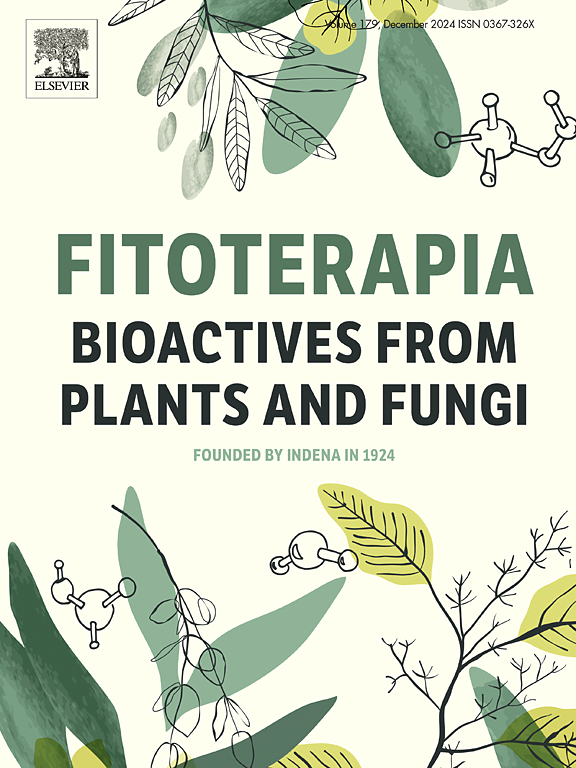从龙葵叶中提取的天然长链脂肪酸酰基茄胺。显示防腐性能
IF 2.6
3区 医学
Q3 CHEMISTRY, MEDICINAL
引用次数: 0
摘要
长链脂肪酰基茄胺,最近在龙葵叶中发现。已被证明具有抵抗植物害虫的能力,如科罗拉多马铃薯甲虫和植物致病卵菌疫霉(Mont.) de Bary。由于其结构与防腐剂十六烷基氯化吡啶相似,本研究旨在评估一种主要含有长链脂肪酸酰基茄胺的甲醇型冬荆叶提取物的部分,以用于潜在的防腐应用。测定了对8种临床相关人类病原体的最低抑菌浓度(mic),并评估了两种模型细菌的最低杀菌浓度(MBCs)。采用原子力显微镜和乳酸脱氢酶(LDH)释放试验研究其作用机制。通过MTT和LDH检测,以及实时细胞分析和活细胞成像,评估正常人真皮成纤维细胞和Vero E6细胞的细胞毒性。该组分对所有病原菌均表现出抗菌活性(大多数病原菌的mic值为128-256 μg/mL),并表现出抗菌性能(MBCs值为256 μg/mL),可能是由非特异性膜破坏介导的。在哺乳动物细胞实验中,该成分反映了MTT实验中氯化十六烷基吡啶的细胞毒性作用(成纤维细胞:IC50 = 1.2 μg/mL, Vero E6: IC50 = 2.2 μg/mL)和实时细胞分析中的特征,表明其作用模式相似。这些发现突出了长链脂肪酸酰基茄胺作为生物基防腐剂的有希望的候选物,为传统防腐剂提供了潜在的绿色替代品。本文章由计算机程序翻译,如有差异,请以英文原文为准。

Natural long-chain fatty acyl solamines from the leaves of Solanum bulbocastanum Dun. show antiseptic properties
Long-chain fatty acyl solamines, recently identified in the leaves of Solanum bulbocastanum Dun., have been shown to confer resistance against plant pests such as the Colorado potato beetle and the phytopathogenic oomycete Phytophthora infestans (Mont.) de Bary. Owing to their structural resemblance to the antiseptic cetylpyridinium chloride, this study aimed to evaluate a fraction of a methanolic S. bulbucastanum leaf extract mainly containing long-chain fatty acyl solamines for potential antiseptic applications. Minimal inhibitory concentrations (MICs) were determined against eight clinically relevant human pathogens, and minimal bactericidal concentrations (MBCs) were assessed for two model bacteria. Atomic force microscopy and lactate dehydrogenase (LDH) release assays were employed to investigate the mechanism of action. Cytotoxicity was evaluated on normal human dermal fibroblasts and Vero E6 cells using MTT and LDH assays, as well as real-time cell analysis and live-cell imaging. The fraction exhibited antimicrobial activity against all tested pathogens (MICs of 128–256 μg/mL for the majority of the pathogens) and demonstrated bactericidal properties (MBCs of 256 μg/mL), likely mediated by nonspecific membrane disruption. In mammalian cell assays, the fraction mirrored the cytotoxic effect of cetylpyridinium chloride in MTT assay (Fibroblasts: IC50 = 1.2 μg/mL, Vero E6: IC50 = 2.2 μg/mL) and the profile in real time cell analysis, suggesting a comparable mode of action. These findings highlight long-chain fatty acyl solamines as promising candidates for the development as bio-based antiseptics, offering a potential green alternative to conventional agents.
求助全文
通过发布文献求助,成功后即可免费获取论文全文。
去求助
来源期刊

Fitoterapia
医学-药学
CiteScore
5.80
自引率
2.90%
发文量
198
审稿时长
1.5 months
期刊介绍:
Fitoterapia is a Journal dedicated to medicinal plants and to bioactive natural products of plant origin. It publishes original contributions in seven major areas:
1. Characterization of active ingredients of medicinal plants
2. Development of standardization method for bioactive plant extracts and natural products
3. Identification of bioactivity in plant extracts
4. Identification of targets and mechanism of activity of plant extracts
5. Production and genomic characterization of medicinal plants biomass
6. Chemistry and biochemistry of bioactive natural products of plant origin
7. Critical reviews of the historical, clinical and legal status of medicinal plants, and accounts on topical issues.
 求助内容:
求助内容: 应助结果提醒方式:
应助结果提醒方式:


